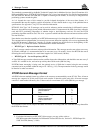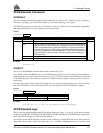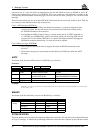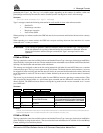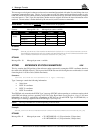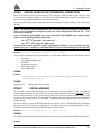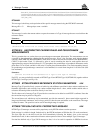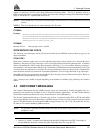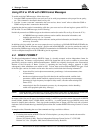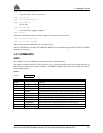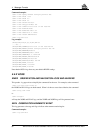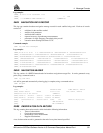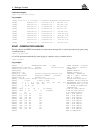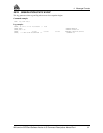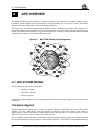
4 Message Formats
56 MiLLennium GPSCard Software Version 4.50 Command Descriptions Manual Rev 1
Using RT-2 or RT-20 with CMR Format Messages
To enable receiving CMR messages, follow these steps:
1. Issue the COMn command to the rover receiver to set its serial port parameters to the proper bit rate, parity,
etc. This command is described in detail on Page 84.
2. Issue the “
ACCEPT COMn CMR” command to the rover receiver, where “COMn” refers to either the COM1 or
COM2 serial port that is connected to the data link.
Assuming that the base station is transmitting valid data, your rover receiver will now begin to operate in RT-2 or
RT-20 mode. To send CMR messages, do the following:
Periodically transmit two CMR messages at the reference station (the station ID, see Page 98, must be
≤ 31):-
• A CMROBS message contains reference station satellite observation information, and
should be sent once every 1 or 2 seconds.
• A CMRREF message contains reference station position information, and should be sent
once every 10 seconds.
In addition to the logs which you can use to output the rover’s position (e.g. POSA/B, PRTKA/B, RTKA/B), the
baseline (BSLA/B), and the reference station’s position and health (RPSA/B), you can also monitor the status of
the incoming CMR messages using the CDSA/B (Communication and Differential Decode Status) log. See Page
144 for a complete description of the CDSA/B log and its arguments.
4.4 RINEX FORMAT
The Receiver-Independent Exchange (RINEX) format is a broadly-accepted, receiver-independent format for
storing GPS data. It features a non-proprietary ASCII file format that can be used to combine or process data
generated by receivers made by different manufacturers. RINEX was originally developed at the Astronomical
Institute of the University of Berne. Version 2, containing the latest major changes, appeared in 1990;
subsequently, minor refinements were added in 1993. To date, there are three different RINEX file types. Each
of the file types consists of a header section and a data section, and includes the following information
4
:
• observation files (carrier-phase measurements; pseudorange / code measurements; times
of observations)
• broadcast navigation message files (orbit data for the satellites tracked; satellite clock
parameters; satellite health condition; expected accuracy of pseudorange measurements;
parameters of single-frequency ionospheric delay model; correction terms relating GPS
time to UTC)
• meteorological data files (barometric pressure; dry air temperature; relative humidity;
zenith wet tropospheric path delay; time tags)
NOTE: Although RINEX is intended to be a receiver-independent format, there are many optional records and
fields. Please keep this in mind when combining NovAtel and non-NovAtel RINEX data.
In support of the first two file types, NovAtel has created six ASCII log types that contain data records in RINEX
format (XOBS, XOHD, XNAV, XNHD, XKIN, and XSTA). A seventh pseudo-log type (RINEX) can be used
instead to simplify data collection. These logs produce multiple lines of output; each line ends with a NovAtel
checksum. Once collected these logs should be processed into the 2 standard RINEX files using NovAtel’s Convert
utility.
A sample session, illustrating the use of the commands and logs, would be as follows:
4. For further information on RINEX Version 2 file descriptions, you may wish to consult relevant articles
in scientific journal such as:
Gurtner, W.G. Mader (1990): “Receiver Independent Exchange Format Version 2.” CSTG GPS
Bulletin Vol. 3 No. 3, Sept/Oct 1990, National Geodetic Survey, Rockville.



